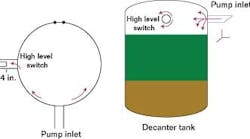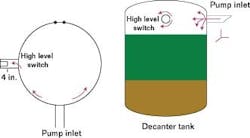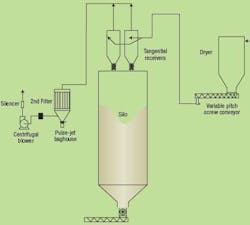Question from March's Chemical Processing
A decanter serves a distillation column used to separate water from solvents. Recovered solvents are then burned in a thermal oxidizer (TOX). The decanter separates the heavy organics, such as carbon tetrachloride, from water. The tank diameter is 48 in. and has a volume of 1,000 gallons. During start-up, it is noticed that the minute the pump begins to fill the tank the high level switch, 90° from the tank inlet, trips the pump off (Figure 1). What can be done quickly to eliminate this problem and keep the overflow safeguard?
Figure 1. Splashing causes high level switch to trip — killing pump prematurely.
Change the pump discharge nozzle
Why not a simple 45°, or 90° ell. Also, a baffle, wrapped around the level sensor, on the pump inlet side. And, there’s always an extension of the inlet down into the fluid, as the ultimate choice. I could go on with siphons, for creating low flow rates.
Tom Murphy, CEO
Puritrol, Inc., Centerville, Mass.
Install an elbow
With installation an elbow at the pump outlet to the decanter we can prevent pump trip.
Jahanian, project engineer
Industrial Projects Management of Iran, Tehran, Iran
Consider three potential solutions
Since we know so little about the cause of the problem, there are a number of solutions, but they reduce to a mechanical solution, an instrumentation solution or a control solution. If this problem exists only during the initial starting of the pump, the level switch could be bypassed for a specific period of time during pump start only. This would be the quickest but not the best solution. However, if the problem persists even after the system reaches steady state then this solution won’t work.
From an instrument perspective, choose a different switch technology. The selected technology should not be affected by the splashing in the tank. An internal stilling well and either a float switch or a radar-type level transmitter inside of the well would be ideal. The well would need to be constructed and oriented so that the openings in the well would be 180°away from the inlet piping. This would have an added advantage of (depending on instrument selection) being able to detect the interface between the two liquids.
Alternatively, a deflector could be added to the end of the sensor pipe to prevent the wholesale flooding of the switch that is occurring now. Since we know almost nothing about the switch except that it appears to be mounted at the outside end of a piping nozzle, this solution could be quick and effective.
The mechanical solution is the one of choice. Add a diffuser to the end of the inlet piping to minimize splashing and turbulence. This should not only eliminate the unwanted trips from the level switch but also greatly improve the separation in the decanter. The decanter should be fitted with several baffles to aid in separation, if they don’t already exist. This will take some time, unfortunately, as it would need to be designed, fabricated and installed. Also the flow rate from the pump into the decanter should be reduced, if possible, to reduce turbulence. An unconventional and quick solution would be to add a flow straightener consisting of numerous small tubes near the end of the inlet pipe at the vessel to develop laminar flow into the vessel and eliminate splashing.
Patrick Richards, senior instrumentation designer
Irving Oil Ltd., Saint John, N.B.
Employ a relay
Here is a process control solution that involves no hardware modifications to the decanter system. This is a low cost and easy solution. The problem appears to be that when the pump starts a sudden inrush of fluid causes a surge in liquid height which then trips the high level switch. Most likely the momentary surge in liquid height dissipates after a few seconds of the pump running.
The solution to avoid the high level switch from tripping the pump is to install a delay in the high level trip on the pump start circuit. This can be accomplished by installing a hardware or software relay switch that needs to be latched for a set time period before the pump start circuit is opened. If the high level switch interlock is in a PLC or DCS control system, try starting off with a 10-sec. delay and then start increasing the delay time until the pump stays on without tripping out. Adding a delay time of seconds to the pump interlock should not increase the risk of the tank overflowing when the level in the tank reaches the high level switch since there is always a buffer distance between the top of the tank and the high level switch.
Mike Dobrowolsky, site utilities leader
GE Plastics, Selkirk, N.Y.
Put in a still well
You didn’t say what type of level switch was being used to shut off the pump. One thing that could be done if it’s a ball float level switch or an ultrasonic probe is to put it still well. This will stop a splashing action that is affecting the switch when the pump is turned on.
Pete Bird, warehouse supervisor
Pioneer Americas LLC, St. Gabriel, La.
Eventually, do a redesign
The problem description suggests that the liquid level in the tank is too high when the liquid isn’t being decanted. The design has flaws but it isn’t the place to criticize it, we need to solve a problem. I would consider the following:
- Lower the liquid level when the feed pump starts so that there’s no splashing of the liquid to activate the high level shut off.
- Install a 90° elbow to introduce the liquid at a good distance below the high level sensor. This will prevent any splashing contact.
For the long term, I would modify the design. Liquids with the density difference of water and carbon tetrachloride and similar liquids can be separated by using a natural gravity decanter with a proper design. They work extremely well and do not require such a high volume tank. Due to the high density difference, the separation is usually quick and clean. Such decanters work fine without any problems, automatically, and continuously. No level controllers are needed; I have designed many decanters and so can state with experience that this one needs to be redesigned.
Girish Malhotra, president
EPCOT International, Pepper Pike, Ohio
Use a baffle
To avoid early kill of the pump, you can add a baffle to the inside of the tank, just before the “high level switch.” Another alternative would be to put a 60°downwards elbow and nipple at the end of the pump outlet into the tank.
Emilio Malaguti, technical manager
Chemtron, Hialeah, Fla.
Go with a programming solution
Without a through detailed examination of the system, a quick test to eliminate electrical noise and/or splash during the initial operation of the feed pump, a quick solution/test would be to put a 2 to 3-sec. delay on the overflow sensor during pump start up. This would eliminate any potential electrical noise being generated by the pump or physical motion as well as liquid splashing on to the over flow sensor.
Mike Bender, project sales engineer
Millipore, Stafford, Va.
Add a time delay
A time delay, on start-up only, should take care of the problem.
Ben Mickler, president
Benchmark Electric, Inc., Raleigh, N.C.
Consider all the options
I am assuming that this is a batch process and it appears that the pump flow is splashing onto the high level sensor. Options to consider: reduce flow rate into the tank by lowering the output from the VFD or by throttling with a valve or an orifice plate; direct the flow away from the high level sensor or re-pipe the nozzle to direct it downward to avoid splashing the sensor; relocate the sensor to prevent it from being splashed — orient it parallel to the flow; and, use a different type of sensor, shorter or one less susceptible to the splashing, install a baffle (still well) around the high level sensor to protect it. There’s a last resort to be considered. If the system absolutely must be operational, can you run it without the high level sensor being on? You could use known flow rate to estimate quantity of liquid in the tank and drive the process by dead reckoning. This method could be augmented by a timer with an alarm. With this approach, the tank volume couldn’t be safely used to full capacity.
John Tashijan, president
T-Squared Associates, Kansas City, Kan.
Install a guard
Place a guard on the pump side of the switch. This will avoid false alarms during pump start by keeping the turbulence away from the switch.
Rick Hildebrand, senior engineer
V2 Bio-Consulting, South San Francisco Calif.
Submerged discharge
Install a 90° elbow and a sub-surface tube on the pump inlet. These two simple pieces of equipment combined would allow the water to enter the tank along the side, below the liquid surface, eliminating splashing. If installed correctly they could remain there as a permanent corrective action.
Kevin M. Nowak, associate scientist
Mentholatum, Orchard Park, N.Y.
Why not gravity feed?
Although I don't understand why the plant is pumping into the decanter. It would be preferable to gravity flow into the decanter to minimize turbulence and promote settling. The feed should be introduced around the interface - perhaps a dip tube can be added - to maximize separation of water from the organic and organic from the organic. Although there are no outlets shown, I assume there will be excess organics in the water phase because of the inlet arrangement. A baffle can be added in front of the level switch to prevent impingement and false readings. A tee or elbow can be added to the inlet to mitigate splashing.
David Greene, Sr. director of bioprocess engineering
PS&S, Warren, N.J.
July's Puzzler
A corrosive material is transported by vacuum pneumatic conveyor from a dryer to silo (Figure 2). The condition at the discharge of the dryer is about 90°F and 75% relative humidity. Since commissioning, during the summer, the blower has suffered reliability problems: seal corrosion, bearing failure, motor trips and noisy operation. In particular, bearing failure has been the number one problem with this blower. Failures are worse in the fall and winter than in the summer. Current readings on the blower tend to increase slightly during the winter but the draw seems normal until sudden failure of the seals or bearings. What is the likely cause and what can we do to reduce reliability problems?
Figure 2. Blower, receivers and baghouse are located outside.
Send us your comments, suggestions or solutions for this question by June 8, 2007. We’ll include as many of them as possible in the July 2007 issue and all on CP.com. Send visuals — a sketch is fine. E-mail us at [email protected] or mail to ProcessPuzzler, Chemical Processing, 555 W. Pierce Rd., Suite 301, Itasca, IL 60143. Fax: (630) 467-1120. Please include your name, title, location and company affiliation in the response.
And, of course, if you have a process problem you’d like to pose to our readers, send it along and we’ll be pleased to consider it for publication.




